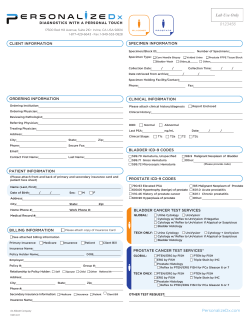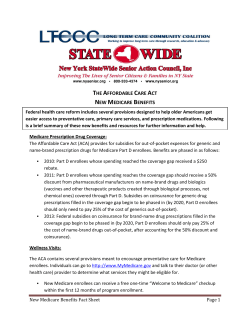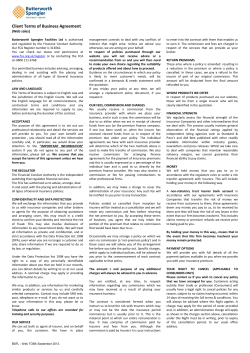
S UBROGATION T HE RIGHT OF YOUR HEALTH INSURER TO BE
SUBROGATION THE RIGHT OF YOUR HEALTH INSURER TO BE PAID BACK WHEN YOUR CASE SETTLES Subrogation: the legal right of an insurance company to be paid back for benefits paid on your behalf after your accident. It is also known as a “right of recovery” or “right of reimbursement”. The most common form of subrogation is when your health insurance provider pays some of your medical bills, and then demands to be paid back for those bills when you receive your settlement or verdict. Subrogation may also apply to such benefits as Medical Assistance, Medicare, or short/long term disability coverage. No Fault Benefits are not subject to subrogation. In auto accident cases the amount subject to subrogation is usually limited to those bills paid after no fault coverage runs out (over $200,000) or after benefits have been cut off. Subrogation does not add to the value of your personal injury case. We cannot ask for more money because you have to pay subrogation. Your insurer claiming subrogation will reduce your net recovery. By negotiating a reduction in the amount your health insurer gets paid your net recovery is increased. The policy language in your health plan will control if and how much your health insurer will have a right to get paid back. By agreeing to “buy” that policy, you agreed to pay them back. For example, the Mayo Clinic medical plan says: By enrolling and accepting coverage in this plan, you agree to the following: The Plan will be reimbursed from any recovery before any payment of any existing claims including any claim made by you for general damage….The Plan may collect from the proceeds of any settlement or judgment recovered by you or your legal representative regardless of whether you have been fully compensated. We will work hard to avoid paying back the health insurer but it is not always possible to avoid. If so, we will try to negotiate a smaller dollar amount with the insurer. Please feel free to call our office if you have any questions or concerns. LETTERS OF PROTECTION A PROMISE TO PAY OUTSTANDING MEDICAL BILLS OUT OF YOUR SETTLEMENT Letters of Protection: formal agreements between yourself, your attorney, and your doctor regarding how you will pay your bills. The letter states that you promise to pay your medical bills out of your legal recovery when your case is settled. If your doctor is unwilling to treat you without a guarantee of payment, or if you have no insurance coverage for your medical expenses, a Letter of Protection may be an option worth exploring. Benefits of a Letter of Protection: •No interest or late fees will be assessed, and no collections agents will bother you while the Letter is in force. •Your hospital or clinic will administer treatment as if you had no outstanding balance. •Your bills are paid in full upon the completion of your case. Things to keep in mind: •Your bills are paid out of your net recovery. My office will pay your doctor out of your settlement. This will reduce the amount you will receive. •Letters of Protection do not increase the amount you can ask for in the settlement. •Not all providers accept Letters of Protection. •If your case fails, it is your responsibility to pay all medical bills. Letters of Protection are frequently provided to our clients, we are happy to handle this for you. Before any agreement is signed it is important for you to fully understand how a Letter of Protection works. Please feel free to call our office if you have any questions or concerns. CHILDREN’S CASES SPECIAL RULES APPLY TO CIVIL CLAIMS BROUGHT ON BEHALF OF MINORS Anytime the plaintiff in a civil lawsuit is a minor (under 18), there are special rules which must be kept in mind. Minnesota Statutes require certain procedures be followed when handling such a claim. These rules affect the ethical obligations if the attorney, require court approval of all settlements, and affect the distribution of the proceeds after the case is resolved. Court Approval of all Settlements By law every settlement involving a child must be approved by the court. This law is in place to protect the child’s best interests from influence from insurance companies, attorneys, and parents. It is also in place because minors cannot legally enter a binding contract. Distribution of Funds Any funds recovered on behalf of the child are placed in trust until the child turns 18. These funds cannot be accessed without a court order. Usually they will be placed in a Certificate of Deposit (CD) or other conservative interest‐bearing investment account at a local bank. After turning 18, the funds are at the child’s sole disposal and discretion. We will be happy to provide a referral to an investment counselor or financial institution that can provide advice to make the most of your child’s asset once they reach adulthood. Structured Settlements A Structured Settlement is an agreement to make a series of partial payments over a period of years, rather than one lump sum payment. In effect, agreeing to a structured settlement is like agreeing to let the insurance company invest the settlement proceeds. Structures do have control over the proceeds after the claimant is an adult, thereby reducing the likelihood that the asset will be squandered. However, most structures pay poor interest rates, and sound investment decisions will add more value to the asset than a structure. Please feel free to call our office if you have any questions or concerns. RULE 68 MINNESOTA’S “LOSER PAYS” RULE In MN the victor of a civil claim can claim for the losing party to pay the out of pocket expenses. It is important to remember that you can end up paying for the defense’s expenses if your suit fails. How Does It Work? Any time prior to 10 days before your trial date either side can make what is known as an Offer of Judgment. This offer is an attempt to settle the claim for a certain amount of money. If the offer is rejected and the jury’s verdict is less than the offer, you will have to pay the opposing side’s litigation expenses. How Much Will It Be? Costs can vary but you should expect to pay several thousand dollars or more. The costs include experts, depositions, and doctors. Depending on if the other side proves to the judge that the expenses were necessary, the judge could include it as well. Can The Plaintiff Use Rule 68? You can use Rule 68, but it is not always effective. Multi‐million dollar corporations do not react the same way an individual does. The plaintiff more commonly uses Rule 68 to counter a previous offer from the defense. Who Pays? Plain and simple, You Do. The firm and your attorneys are not responsible for the expenses. The judgment is against you, so you are responsible to see it paid. Often insurance companies do not collect on these judgments if you agree not to appeal. There is no guarantee that they will not collect. Please feel free to call our office if you have any questions or concerns. MEDICARE FEDERAL GOVERNMENT REIMBURSEMENT RIGHTS DELAY PERSONAL INJURY CLAIMS Any personal injury claimant who is Medicare eligible, or may be eligible within the next 30 months must report claims made and comply with federal reimbursement requirements. What Must Be Paid Back? If Medicare paid medical expense benefits on your behalf, they must be repaid out of your recovery. How much they get paid depends on what kind of claim it is and how much is recovered. What if Medicare Hasn’t Paid Anything? The good news is they shouldn’t be entitled to any portion of your recovery. The bad news is that the reporting requirements still exist and we still must get the “no interest” letter from Medicare allowing us to disburse your funds after settlement. What is the Big Deal? Medicare’s right to be repaid is not a big deal, in fact that concept is called subrogation and it is a common right by any insurer who pays medical bills on behalf of an injury claimant. The problem is that getting Medicare to give us a simple accounting of what they have paid or confirmation that they have no interest takes a very long time and delays our ability to disburse funds to you even after your case is settled. How Long Does It Take? The honest answer is – we have no idea. The Medicare rules set forth timing requirements, but because Medicare is constantly failing to do what they say they will do, or simply entering the information in your file incorrectly, it is our experience that the timing is unpredictable at best. It is not uncommon for the process to take 3‐9 months after settlement before we are free to disburse funds. Please feel free to call our office if you have any questions or concerns. MOBILE MRI CONSIDER THESE SERVICES CAREFULLY Many chiropractors use a mobile diagnostic service to have their clients receive an MRI. These are very expensive, are often not covered by health insurance or no fault, and may not enhance the value of your case. We encourage you to consider your alternatives before agreeing to use these services. What is the Problem? Several companies in Minnesota provide mobile diagnostic services so that local chiropractors can have access to MRI scans. The billing for these services is often not covered by health insurance and is often denied for payment by no fault companies. My Doctor Recommended It – What Choice Do I Have? Discuss your options with your doctor or chiropractor. It is often better from a billing standpoint, and more likely to be accepted by the insurance companies, if the imaging is done by a local medical facility. A simple referral to your own family physician or local clinic may be a better alternative. Be Aware of Hidden Costs and Collections. These images are expensive. We have seen several examples of clients who have received these services, and when the bills are not accepted by insurance they wind up owing thousands for the imaging and hundreds more in interest and finance charges. Oftentimes these companies are very aggressive in collecting their money, and request the patient sign a form promising to pay them out of the settlement before the claimant is entitled to anything. Please feel free to call our office if you have any questions or concerns. Damages What is your Case Worth? The value of your case is determined by who is at fault for the accident, the amount of available insurance, and the severity of your injuries. The case is worth whatever a jury may award were it to go to trial. Do not be fooled by what you see on TV, jury awards are typically very conservative, and are getting smaller all the time. LIABILITY and NO FAULT In most automotive accidents, there are two claims which arise at once: the No‐ Fault claim against your own insurer for past medical expenses and past wage loss, and the Liability claim against the at‐fault driver for all other damages. Tort Thresholds Under MN law, you must meet one of the following thresholds in order to bring a liability claim: •Non‐diagnostic medical expenses exceeding $4,000 •Permanent Injury based on a Doctor’s report •Permanent Scarring •60 days of work disability based on a Doctor’s restriction •Death We will be monitoring your case, and if it appears unlikely you will meet any threshold, we will notify you by letter and simply close the file at no cost to you. If you do meet a threshold, we will be in a position to evaluate the claim once we have a final Narrative Report from your treating physician. Elements of Damages in a Liability Claim There are six elements of damages under MN law in the typical liability claim. They are: •Unpaid past medical expenses •Unpaid past wage loss •Past pain and suffering •Future medical expenses •Future wage loss •Future pain and suffering. Past medical and wage will only include items unpaid by no‐fault. All of these damages require medical testimony so it is very important for you to treat consistently and follow your doctor’s orders. For Example: a soft tissue (like whiplash) injury is worth approximately $7,500‐15,000 dollars. However there are always factors that will raise or lower your personal claim. This is a significant amount of money but unlike what people expect based on TV shows. Please feel free to call our office if you have any questions or concerns.
© Copyright 2025





















